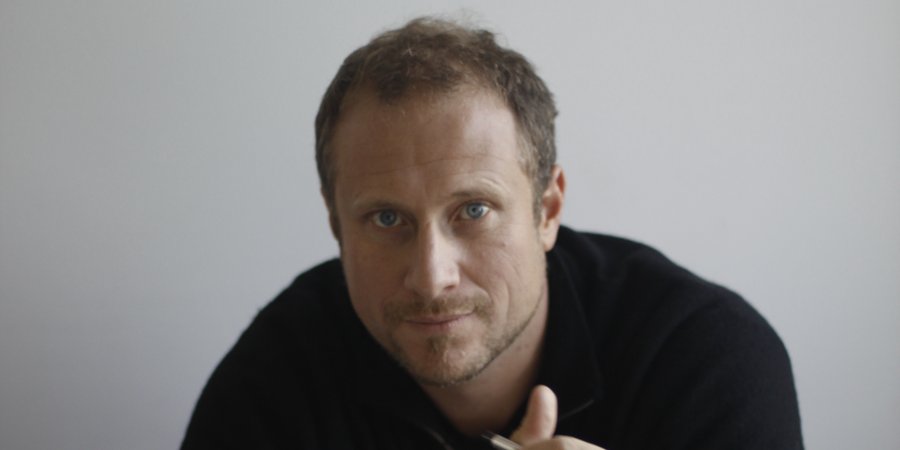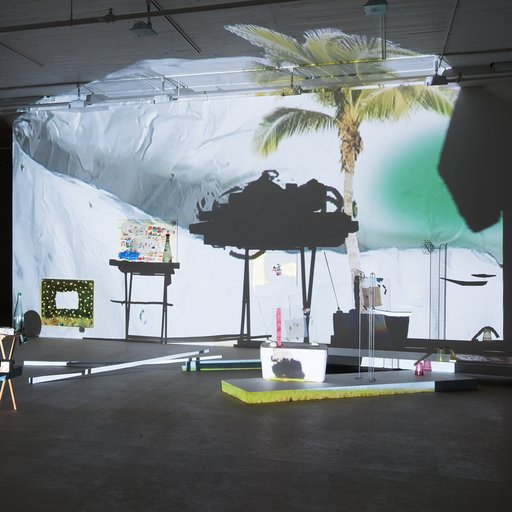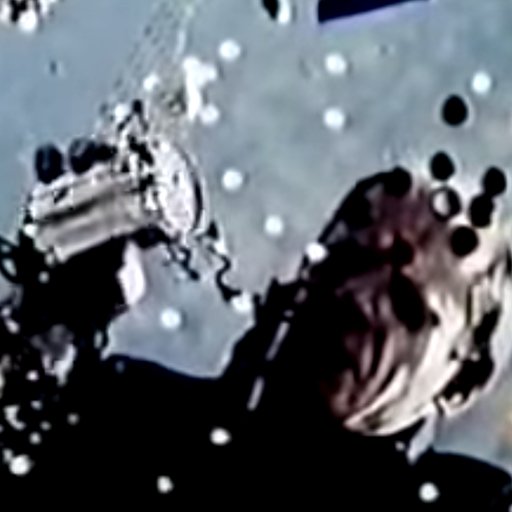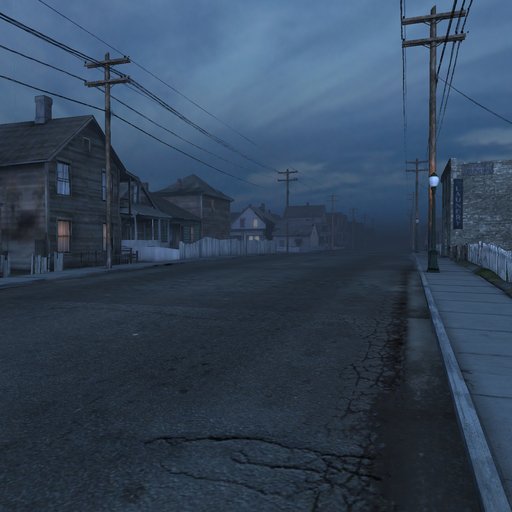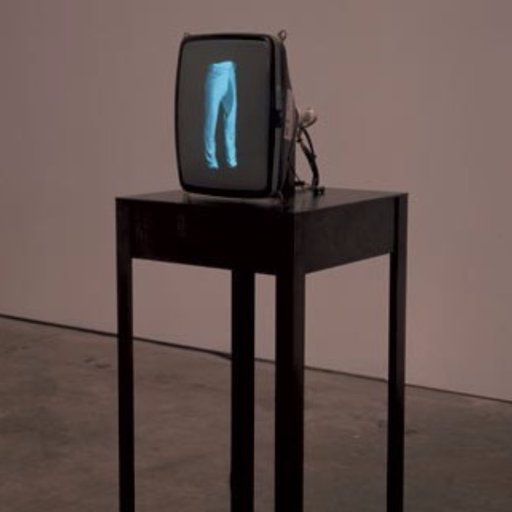Trevor Paglen has tracked secret spy satellites, photographed so-called “black sites” like Area 51, cataloged hundreds of classified codes for military operations and their associated (and often bizarre) patches, and blasted images into space for the benefit of future civilizations or a visiting alien species. With a Ph.D. in experimental geography ( it’s more than just maps ) from the U.C. Berkeley and an M.F.A. from the School of the Art Institute of Chicago , Paglen approaches art with a steadfastly interdisciplinary and collaborative mindset, combining his academic training with an eye for aesthetics and a healthy dose of post-9/11 paranoia. His work has become increasingly relevant as questions about privacy and state power has moved from the fringes into mainstream political discourse, positioning Paglen as a central member of the artistic vanguard taking a hard look at the technological forces shaping the 21st century.
In his new exhibition at Metro Pictures in Chelsea (on view September 10-October 24), Paglen turns his attention to the shadowy mass surveillance projects carried out by the NSA —the same efforts so dramatically revealed by Edward Snowden with his release of classified government documents in 2013. Indeed, the exhibition seems to be an homage of sorts to Snowden’s historic actions. Paglen used the leaked files to find and photograph the cables the U.S. government has tapped in order to spy on the World Wide Web. (Doing so required poring over nautical maps, hiring boats, talking to specialists, and learning to scuba dive, altogether just a sampling of Paglen’s research-heavy process.) With the help of fellow activist Jacob Applebaum , he also constructed Autonomy Cube , a usable Wi-Fi router running the anonymizing web browser Tor . Also in the show is a new film by Paglen, a compilation of footage of government facilities originally shot for the Oscar-winning Snowden documentary Citizenfour .
To find out more about Paglen’s approach to this loaded subject matter, Artspace’s Dylan Kerr met with the artist at his New York gallery. There, he discussed the plausibility of chemtrails, the art of institutional enhancement (as opposed to institutional critique), and why we shouldn’t put too much faith in photographs.
There’s an interplay between the legwork required by your projects and the aesthetic objects that arise out of this planning and research. This exhibition, for example, had you studying thousands of government documents, scuba diving, and researching Internet anonymity software all before you photographed or constructed anything, but the results don't readily communicate this effort. How do you think about these two sides of your work?
For me, it’s definitely a continuum. I think about my works as objects, and I actually think about them as very art-historical objects—objects that are consciously speaking to different aesthetic and intellectual histories. As an artist you’re always speaking to your ancestors as much as you’re speaking to your contemporaries, but there is a tension or dialectic between these aspects of my work. I do quite a lot of research in order to produce these images that are, quite often, really nondescript, that in many places threaten to become color fields. I think that tension is really what I do. There is a tension between the process and the image, but I think there is also a kind of meta-project about images themselves and their limitations that is inherent to this work.
As you said, many of the images you work with require a certain amount of conceptual framing or storytelling in order to become legible as records of the secret worlds around us. The meta-project you mention has the issue of trust as one of its central features: we have to believe you when you say that this is a photograph of an NSA black site, a tapped Internet cable, or a Predator drone.
Absolutely. In the first show that I did of the spy satellite project, where I was using photographs to track secret satellites, a critic said that these images could just as easily be a scratch on the film.
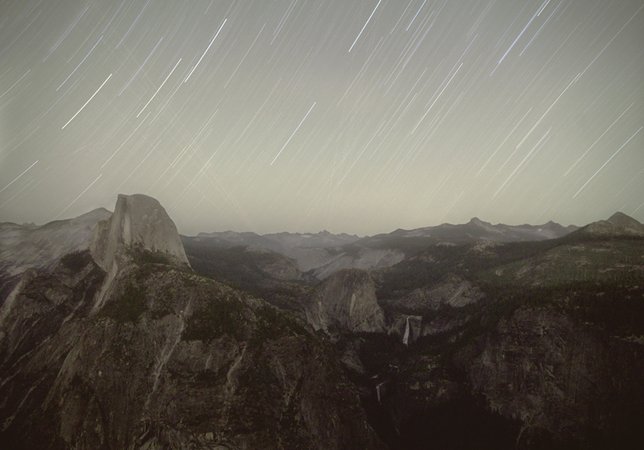 KEYHOLE IMPROVED CRYSTAL from Glacier Point (Optical Reconnaissance Satellite; USA 224)
, 2011
KEYHOLE IMPROVED CRYSTAL from Glacier Point (Optical Reconnaissance Satellite; USA 224)
, 2011
Exactly my point. Why then should we trust you to make reliable images? How does belief play into your work?
This is a great question, and one that I think is at the core of my work. Historically, there has been this figure of the reliable witness, going back to the Enlightenment. The question was, “How can you trust an observation?” The answer was that an observation can be trusted if it comes from a quote-unquote reliable witness. There’s a whole history of contesting what qualifies as a reliable witness and what the status of that is. I’m not trying to solve that problem for you, but the fact that that problem exists, the fact that you brought that up as a problem, is an indication that the work is communicating in the way that I want it to.
Your work seems to reference the supposedly indexical relationship of photography to reality, where the photograph is always an “honest” or “true” record of a scene.
Exactly. My friend Rebecca Solnit always talks about what she calls “the aesthetics of objectivity,” which is that there’s a way that you can make an image that has an aesthetic of truth to it. Most of the images that I use don’t have that trope. The point that she makes is that that documentary or objective aesthetic is also an aesthetic—it’s nothing that’s inherent to the images themselves. Images are always some kind of interplay between a thing that we’re looking at and the preconceptions that we bring to the thing that we’re looking at.
Your body of work seems to consist of a series of small political gestures that seem more symbolic or emotional than effective. You’re taking on massive, world-shaping institutions like the NSA or CIA with blurry photographs that, by your own admission, hardly register as records of anything at all. Even The Last Pictures project, where you attached a series of images to an orbiting satellite in an effort to leave a record of our times for future human or extraterrestrial observers, is an almost comically ineffectual gesture that will almost surely be lost in space and time. Why work in such small acts?
I’m glad that you talk about The Last Pictures as a small act—one of the things that people critique about that is that it was a grandiose gesture, but I always thought about it as a minor gesture. For me, the grandiose gesture was Lockheed Martin putting 200 communications satellites in orbit around the earth [laughs]. I’m interested in the interface between these large structures—whether it’s mass surveillance or the universe—and your lived experience, and between those structures and your body.
In the case of surveillance, you know in the back of your mind that Facebook and Google are surveilling you, but that’s still pretty abstract. Given the way we understand the world through metaphors and vocabularies, I feel that going out and diving to the bottom of the ocean and photographing a cable adds a set of images and a vocabulary for my understanding of the world that didn’t exist before. Hopefully, that can translate to other people. It’s a gesture that I think a lot of people can relate to, and I think making those images is productive epistemologically as well.
 Columbus III, NSA/GCHQ-Tapped Undersea Cable, Atlantic Ocean
, 2015
Columbus III, NSA/GCHQ-Tapped Undersea Cable, Atlantic Ocean
, 2015
Can you say more about that? How are these images productive? On the flip side, why present these images in a gallery, as fine art objects? What does that accomplish?
Art can do a whole lot of different things, and art is a lot of things. The kind of art that generally excites me is art that helps us or helps me to see the historical moment that we’re in. I mean that super-literally—I mean literally seeing. There’s a whole history of artists that have been specifically concerned with that question, including someone like Picasso [laughs]. That’s one of the image-making traditions that speaks to me the most.
In terms of putting it in the gallery, on the one hand there is a big chunk of art history that has done exactly that. The other thing is that I like putting things in galleries and museums because there are actually not very many spaces in our society or in the world that are dedicated to looking at and contemplating images. I think that by putting images in a gallery, you create a space whose purpose is to be a place where you go to look at and think about images. There’s an attention that you draw to them that is unique to that kind of space. It’s also a way of deciding and stating that this is something the culture should be paying particular attention to. From the trillions of images and concepts in the world, it’s a way of picking a few and saying, “I think we should all really take a look at this right now.” These institutions allow you to do that.
For me, much of your work has an undercurrent of hope in the face of massive, often invisible adversity, something that I see manifesting especially strongly in your Autonomy Cube . This piece, which you present as a sculpture, is in fact a functional Wi-Fi router that uses the Tor Network, the now-infamous web browsing service that preserves users’ anonymity by scrambling their identities as well as their locations. Does the rise in popularity of these kinds of anti-surveillance technologies give you hope for the future?
I’ll put an addendum onto what I was just saying. The main thing that I want out of art is something that makes us see the historical moment that we live in. What I want a little bit out of art is something that helps us see how that historical moment could be different. It’s not so much a question of imagining as it is looking in a more concrete way at how things can be different.
I’ve always thought about how technology is not neutral. Technologies always have ethics and social engineering built into them by virtue of the simple fact that technology allows you to do a certain range of things and forecloses doing a certain other range of things. For example, the ergonomics of a computer itself forces you to sit in front of it typing and forecloses the possibility of, I don’t know, having more physical interactions with other people. This is a super-basic, almost ludicrous example, but this is the kind of thing that I mean.
Something like Tor is an infrastructure—it’s an infrastructure that does something very similar to what the normal Internet does and actually sits on top of the normal Internet, but the ethical scripts that are embedded within it are very different from something like Google’s version of the Internet. For example, Tor is run by volunteers. The whole network is made up of volunteer relays and servers. In fact, the Autonomy Cube is a relay itself, so it’s not just this Wi-Fi hotspot that anonymizes traffic, it’s a relay that allows people from all over the world to use the gallery or museum’s internet connection to anonymize their own usages and locations.
In a larger sense, what I like about the Autonomy Cube is that it’s an image that is actually a piece of infrastructure. Take a museum: it has an infrastructure that has ethical relationships embedded within it. How about we insert this thing that in some small way changes around the ethical relationships of that infrastructure? I very much think about the piece as being historically aligned with the history of institutional critique and people like Hans Haacke and Andrea Fraser, but it’s actually not a critical project. I think about it as institutional enhancement, in the sense that if you install this piece it helps your institution fulfill what its mission should be. It makes it a more civic place.
This is also happening at the moment when museums are deciding how to use technology. There’s a whole industry that wants museums to install tracking and facial recognition technologies that monitor everything from visitor attendance to what kinds of artworks people are looking at. There’s an opportunity at this particular moment for museums to say, “No, actually these should be more autonomous spaces that are free from tracking.” The other option is to say, “Well, museums are basically like department stores, so we should be figuring out what people are looking at and doing metrics on that data.” I clearly have a preference for the former, but there are no tools. There are a lot of tools for the latter, and corporations want to give them to museums.
 Autonomy Cube
, 2014
Autonomy Cube
, 2014
You mentioned during our tour of the show that you see Tor as simply a tool, one that can be used for good, evil, or anything in between. You highlight this potential by actually setting up a usable Tor relay. Do you see the more research- and action-based part of your process—diving to the bottom of the ocean to look at tapped cables, for example, or delving into the now-public NSA files to uncover various state secrets—as demonstrations of what individuals can do themselves with an eye towards building new ethical relationships via technology?
Absolutely. On one hand, I have faith in art, but at the same time a lot of different people do a lot of different kinds of things, and that overall sculpts the way that the world works. There are a lot of people in the technology industry who are working on these kinds of issues. There are a lot of people in the civil liberties community that are working on these kinds of things. I actually talk to a lot of these people from a lot of different fields to really think about how a vision of the present and a vision of the future get created.
What do you make of the increased awareness of the surveillance state in the wake of the high-profile leaks of the past several years? I think most people were vaguely aware that governments and companies were probably watching us, but seeing it in black and white with the release of these documents has really changed the way we talk about these issues.
That de-abstraction of these issues can be very powerful, and we see that with the Snowden documents. Those specificities are very powerful. We all quote-unquote knew that AT&T and Verizon were collaborating with the NSA, but when you actually have the court order in your hand, the conversation changes.
Do you see this awareness translating into action on a more everyday scale?
First of all, there’s definitely much more awareness around the issue among people who are in journalism or filmmaking or cultural production or humanitarian work or medical work—in a lot of different fields, this problem of mass surveillance has really been underlined in some powerful ways. I think the fact that it’s on the agenda is a good thing. Look at climate change—people have known about climate change for decades, but there’s now a lot of movement towards trying to reform it in order to redirect human history so it's not so self-destructive.
In the case of climate change, it’s possible it may be too late. Something similar could happen with mass surveillance. I think there is a tipping point where it becomes too late, and maybe we’ve crossed that point already—but at least the conversation is happening. At least people are aware that it’s going on, which is different than how it was being done before. It was all being done in secret—secret courts, secret laws, secret interpretations of laws. It’s better now, but it’s still there. It is good that people have an awareness of it.
It seems like there could be an affinity between your chosen subject matter and the interests of groups with a more conspiracy-theory-esque bent. I’m interested in what you make of these kinds of theories—do you see them as subaltern efforts to get at what’s really going on in a way not dissimilar to what you’re doing here, or do you think they stem from some kind of misunderstanding?
It’s actually less and less that I come into contact with those worlds. If I gave a talk somewhere ten years ago, there’d be lots of conspiracy people wanting to talk about chemtrails and whatnot. I don’t know why that has basically gone away in terms of my own experience of who comes to see the work. I do think that a lot of that is, as you said, subaltern efforts to understand the world. People have a sense that there’s something deeply wrong and that there are secret, invisible levers of power that are being pulled that are dramatically affecting the visible landscape, and that’s true. On the other hand, there’s actually a lot of training, intellectually as well as methodologically, that goes into researching some of this stuff. I think that’s its actually pretty specialized training, and it’s training that a lot of people don’t have.
 Untitled (Reaper Drone)
, 2010.
Untitled (Reaper Drone)
, 2010.
What kind of training are you referring to?
I’m talking about basic investigative tools, like how you get certain kinds of documents, but also a kind of epistemological training, like what kinds of conclusions you can reasonably draw from certain kinds of evidence. Not only that, but you have to get a pretty deep understanding about how infrastructures work in order to be able to figure out what’s reasonable and what’s not.
Let’s take chemtrails as an example: there’s this theory that plane contrails are chemicals that are being sprayed to brainwash people or something like that. Yes, there are giant infrastructure projects that are designed to brainwash people. That exists, in things like advertising industries. With this particular program, you’d say, “OK, if there are chemicals being made, there has to be a factory somewhere that makes the chemicals.” Maybe there’s a secret military chemical factory, but, actually, no such thing exists. Who’s making these chemicals? DuPont? [Laughs.] There also has to be some sort of infrastructure at airports to install these things on airplanes which means there has to be people who are trained to handle these kinds of chemicals and that means that there’s going to be chemical spills which means that there has to be some kind of hazmat team that comes to clean these things up when they spill.
The point that I’m making is that you have to be trained or train yourself in order to articulate a problem that way, to come up with an investigative methodology. I think about it like this: you can do something in secret over there, but the thing you’re doing in secret over there has to intersect with something that I can see somewhere. The question then is where those intersections are. In the case of chemtrails, I know that you’re going to have chemical spills if you’re handling chemicals, so I can go and look up how many hazmat responses a fire department made to an airport every year and what chemicals were present at that response.
You have to learn how to think that way, and moreover learn how to do that kind of research—tracking down documents, asking the right people. Some of the people that we might talk about as so-called conspiracy theorists are actually pretty good about that stuff, but there is also a kind of intellectual self-discipline that has to come with that. Some people make a living out of promoting these kinds of conspiracy theories, and they do it by drawing unreasonable conclusions from real evidence.
When you’re researching and photographing these restricted areas, do you ever run into legal difficulties, both in person and after the fact?
I’m very careful not to break the laws. I really spend a lot of time understanding the legal landscape I’m working within.
 Detachment 3, Air Force Flight Test Center #2, Groom Lake, NV, Distance ~26 Miles
, 2008
Detachment 3, Air Force Flight Test Center #2, Groom Lake, NV, Distance ~26 Miles
, 2008
Is that a rule or boundary that you’ve set for yourself, that everything you do is going to be above-board and legal?
Absolutely, but that’s how democracy works. If you look at or say something and somebody gets upset, that’s fine. But yeah, I don’t break the laws. I’m very conscious of that in everything that I do. Having said that, if you show up at a military base and start taking pictures from the fence somebody’s going to come out and talk to you. That’s fine. I’ve had a huge range of interactions in those kinds of situations, but I’ve never sacrificed my film, I’ve never given my film away, and I’ve never deleted a photograph. Sometimes that means that you’ll sit there for four or five hours while commanders and lawyers get called. Usually, it all works out.
Do you have some kind of legal counsel on-hand to help you in these kinds of situations?
Yeah, for different projects and in different countries it can be different people. When we were shooting a bunch of stuff for Citizenfour in Germany, we had a German lawyer on speed dial, and we were working for Der Spiegel at the time so we were ready to call them too. Usually it’s not necessary.
Speaking of Citizenfour , how did you get linked up with Laura Poitras and the rest of team behind the film?
I’ve been friends with Laura and those guys forever, so in a way it felt like a very natural collaboration because it was about stuff we were all looking at.
Given the massive success of the film, what do you make of Snowden as both a pop culture and historical figure?
I think the thing that everybody worried the most about with Snowden was that nobody would care, and that has been thoroughly debunked. A lot of people care a lot, which has been very vindicating. I have a lot of thoughts about Citizenfour . To be clear, I didn’t see the film until it premiered at the New York Film Festival, the same as anybody else. I had only seen the stuff that I worked on, which was only landscapes. This exhibition at Metro Pictures is really based on research I did for Citizenfour , which was looking at how a signals intelligence infrastructure works in relation to the Internet and fiber-optic cables and things like that. The question was, “Where in the world is this stuff?” That’s what I went out and shot.
I think Citizenfour is important because it put mass surveillance on the agenda. In that sense, the film is part of a much bigger project of dealing with the archive and trying to tell stories about the ways in which the law has been interpreted in secret to allow things that people didn’t understand were going on. This larger project deals with everything from that to how routers have been intercepted by the NSA, how the actual hardware of the Internet has been made hostile or been weaponized. There’s a huge range of things within that. In reporting on the archive, there’s everything from the abstraction of mass surveillance to the hard fact that AT&T has a switch in this building that is being used to do these five digital attacks against this guy in the U.N. and these are the names of those attacks and how they work.
When Citizenfour won the Oscar, it was great to see a kind of vindication of Snowden and what he had done. It’s an indication that a certain version of common sense in the U.S. says that this guy did the right thing. He exposed crimes. He showed that that Jim Clapper and Keith Alexander lied repeatedly to the American people and to Congress about these programs and that this is not OK, despite the fact that they still somehow have their reputations. The thing that was so impressive to me about Citizenfour is that it’s a real-time film of history happening. You can see that there’s a guy in a hotel room and that he’s terrified. He’s basically decided to commit suicide—in the sense that he’s resigned himself to the fact that he’s going to prison for the rest of his life—but at the end of the film he’s decided that he doesn’t want that. You see that play out in this very intimate way, and as an historical document it’s a beautiful portrait of a significant moment in history and of somebody who is, in a way, driving that history, with all the insecurities and fears and courage that embodies.











